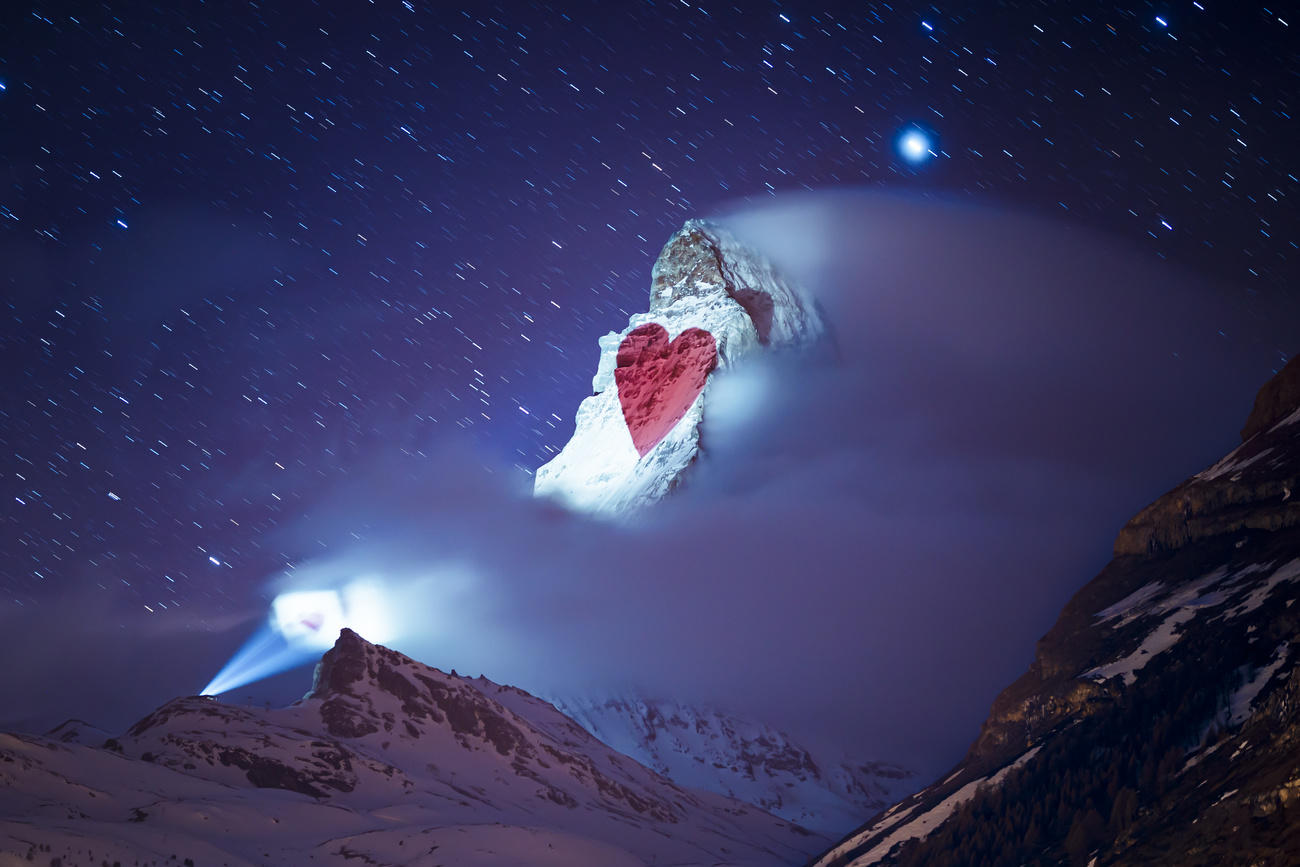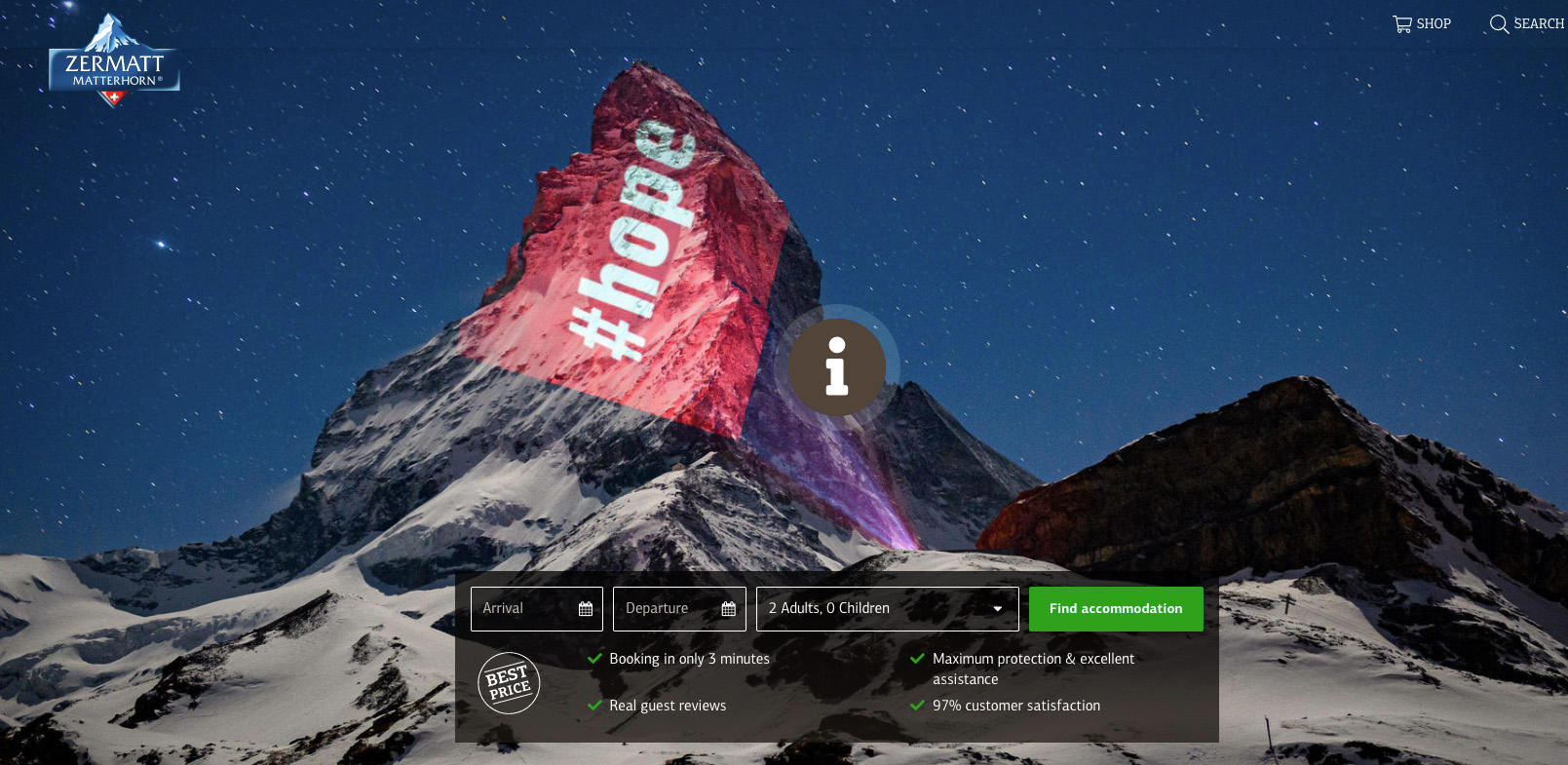
Matterhorn light show sparks joy and dismay

Art? Light pollution? A beacon of hope? A PR stunt? The nightly displays on the Swiss side of an iconic mountain peak are entertaining virtual visitors while worrying conservationists.
Since March 24, Swiss light artist Gerry HofstetterExternal link has been beaming images onto the face of the Matterhorn above the resort of Zermatt, Switzerland. The motifs vary: flags, hashtags, icons and short messages.
“The community of Zermatt asked if I’d be willing to live up here in a camp for a few weeks during the coronavirus crisis. The light is a sign of hope that our six-person team is giving the world,” Hofstetter told SWI swissinfo.ch via mobile.
He was speaking from the camp pitched at an elevation of 3,000 metres. What started as an “adventure vacation” turned into a “survival camp” after a few days.
“We sacrifice ourselves; it’s so cold [-22°C one night] and we’re lugging water for two hours or more.” Hofstetter isn’t being paid; he said he has an “innovative agreement” with the community of Zermatt to cover costs like food, transportation and electricity.
Each day he consults with the mayor of Zermatt and the CEO of Zermatt Tourism to decide which image should be projected next. According to Hofstetter’s team, the nightly displays have reached over 2.2 billion people via traditional, online and social media.
The world is fighting COVID-19 together.
— Narendra Modi (@narendramodi) April 18, 2020External link
Humanity will surely overcome this pandemic. https://t.co/7Kgwp1TU6AExternal link
Not everyone is as enthusiastic as India’s prime minister or the US embassy in Bern.
“This is a protected, natural heritage landscape, so it shouldn’t be disturbed by artificial lighting,” said Lukas Schuler, the president of Dark-Sky SwitzerlandExternal link, an interest group concerned about light pollution.
He told SWI swissinfo.ch that animals like alpine ptarmigan and ibex are bothered by the light – even if you don’t see them running away. “It always has an impact, and you don’t know how much.”
The Matterhorn livestreams run for a couple of hours per night. Rather than cutting the lights at 10pm – which is the norm (see box) for non-essential outdoor lighting in Switzerland – the shows are scheduled with moonlight and time zones in mind. For example, the US flag appeared at midnight on April 16, the Chinese one at 2am on April 19.
And unlike more permanent displays – such as those on urban monuments like the Lucerne water tower – the projection isn’t tailored to the contours of the mountain. This means light is beamed beyond it.
“Light pollution against the pandemic? In our eyes, this staging is above all an inappropriate marketing stunt,” wrote Mountain Wilderness Switzerland on its Facebook pageExternal link.
Asked about the criticism of groups like Dark-Sky and Mountain Wilderness, Hofstetter said: “I’m doing a projection for a limited time where no animals are, and if they would count all the football fields from around the world – during games and training – there would be no comparison in terms of the amount of light.”
‘Extraordinary circumstances’
Switzerland Tourism (ST)External link does not find the display problematic.
“Permission from the local authorities would never have been granted in ‘normal’ times,” ST spokesman André Aschwanden told SWI swissinfo.ch. “But given the extraordinary circumstances of the coronavirus, the involved parties agreed about the importance and meaning of this message of hope and solidarity.”
ST’s current slogan, “Dream now – travel later”, was featured on April 8:
Very early this morning we received this lovely message directly from the #MatterhornExternal link and @zermatt_tourismExternal link ♥🏔️ #dreamnowtravellaterExternal link pic.twitter.com/LBSaSS1T0YExternal link
— Switzerland Tourism (@MySwitzerland_e) April 8, 2020External link
“It’s so brilliant, and so in line with #StayHome,” Hofstetter said. Everybody, whatever their time zone, can go and scroll back in the webcams of Zermatt to see. It’s an incredible fuel-saving project. You can’t visit Switzerland now to see it.”
But surely it might motivate plenty of would-be visitors to come later?

“Of course, you may travel later to see the Matterhorn when the crisis is over. All you need is some time and money to visit Zermatt, but that’s another issue,” Hofstetter said.
Romy Biner-Hauser, the mayor of Zermatt, says there is no commercial or political motivation behind the light show. “It’s to express our solidarity. So it’s no coincidence that we started with [the flag of] Italy, which is so close to Zermatt and so badly affected,” she told SWI swissinfo.ch.
Dark-Sky’s Schuler is concerned that the month-long Matterhorn display will inspire similar light shows – like this one in Dubai:
“I see the point of the symbolism and the message,” Schuler said. “For one evening we could understand making an exception. But it’s been going on for weeks now.”
Hofstetter and his crew will come down on April 27, the day Switzerland is to begin easing the lockdown measures.
Light pollution and the law
Whereas campaigners see light pollution as a form of environmental pollution like noise, air or water pollution, the law generally does not.
Norm SIA 491External link, which came into effect on March 1, 2013, says that “disturbing” light sources that do not have a security purpose (i.e. they are used for decoration or advertising) must be turned off between 10pm and 6am. Christmas decorations are an exception, which may be on until 1am from the beginning of Advent until January 6.
An individual can only demand these lights be turned off between 10pm and 6am if he or she lives within 100 metres of them.
Conservation groups may also lodge complaints on behalf of affected wildlife.
What do you think? Let us know in the comments or contact the author of this article on Twitter: @SMisickaExternal link
With input from Olivier Grivat and Thomas Stephens

In compliance with the JTI standards
More: SWI swissinfo.ch certified by the Journalism Trust Initiative





























You can find an overview of ongoing debates with our journalists here . Please join us!
If you want to start a conversation about a topic raised in this article or want to report factual errors, email us at english@swissinfo.ch.